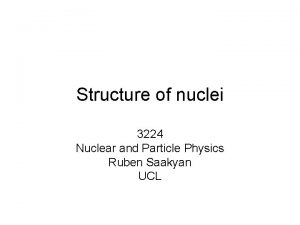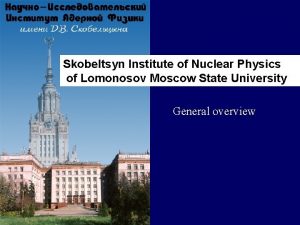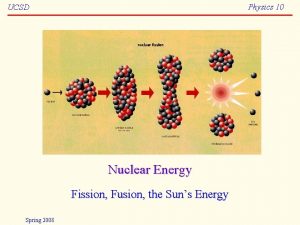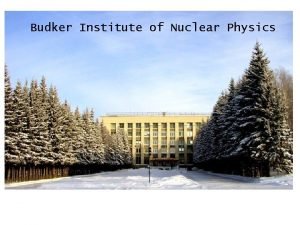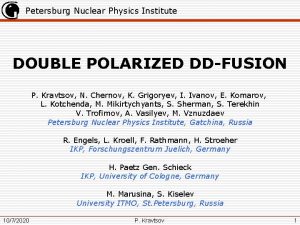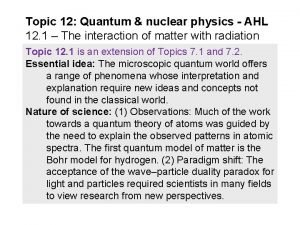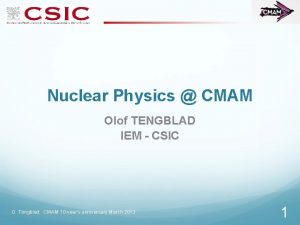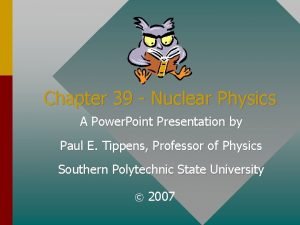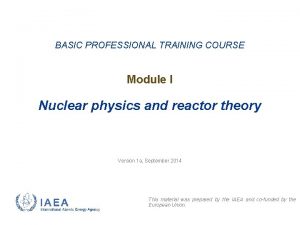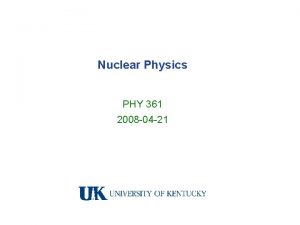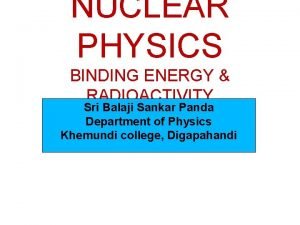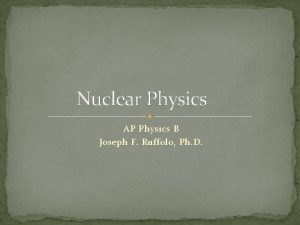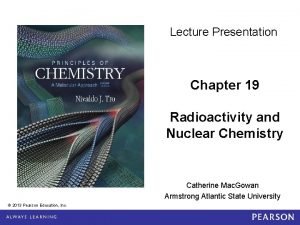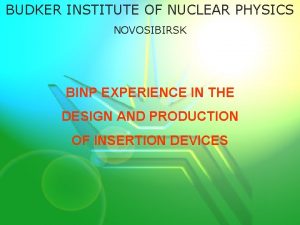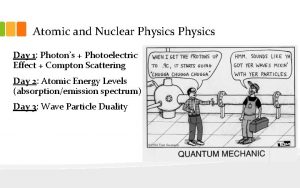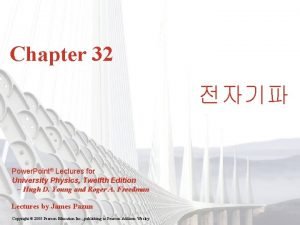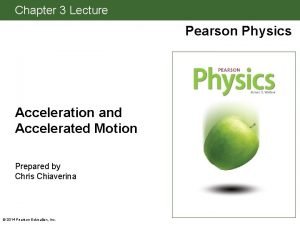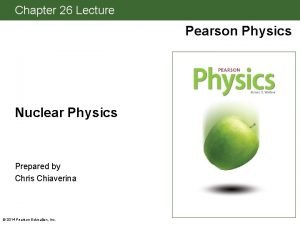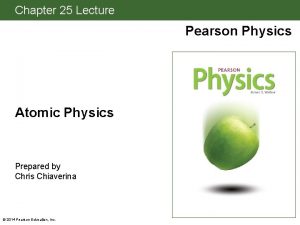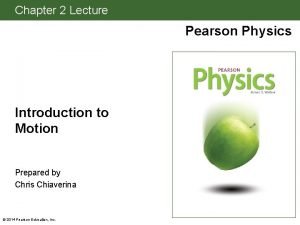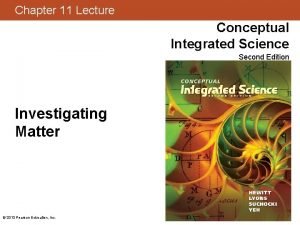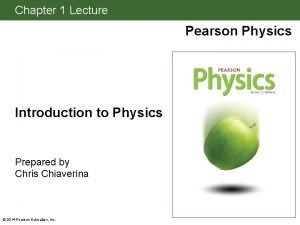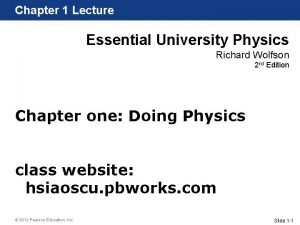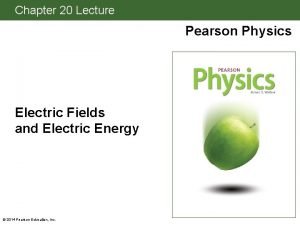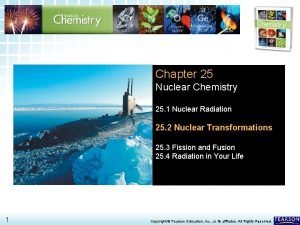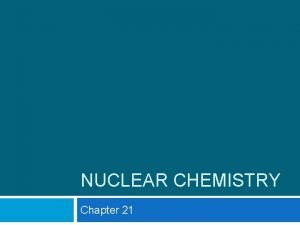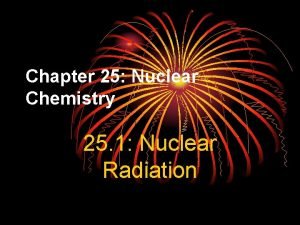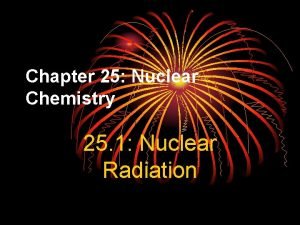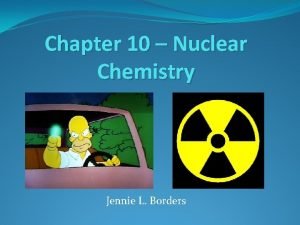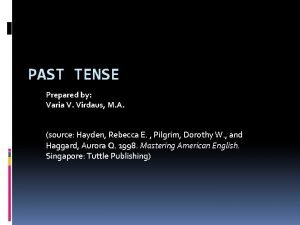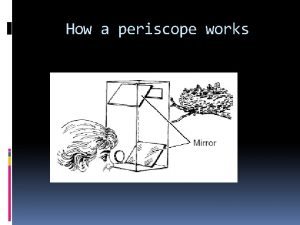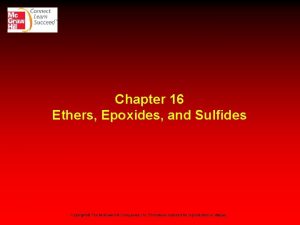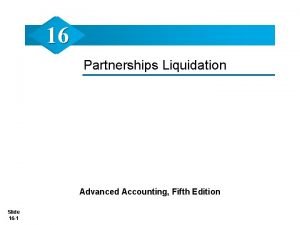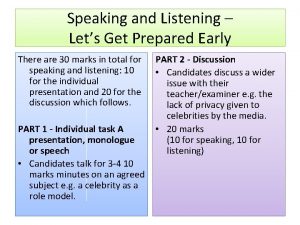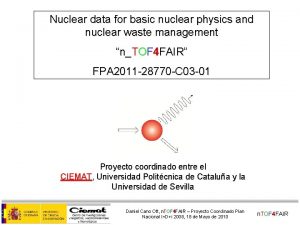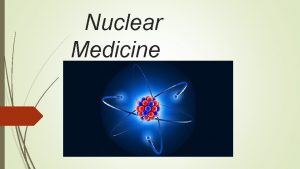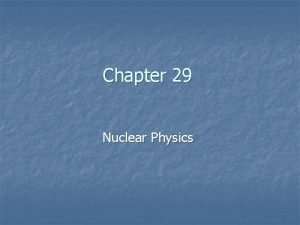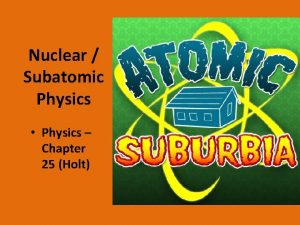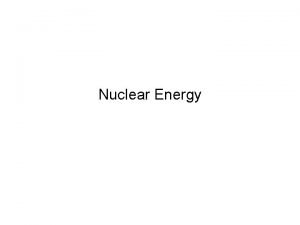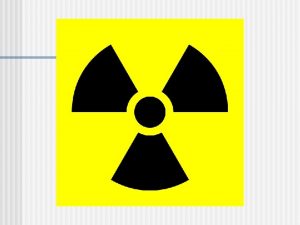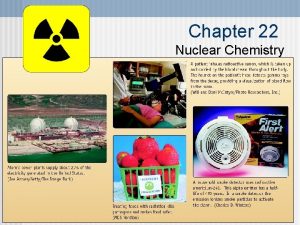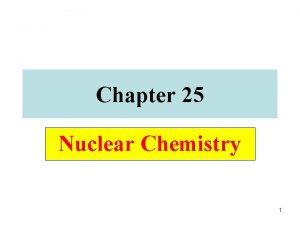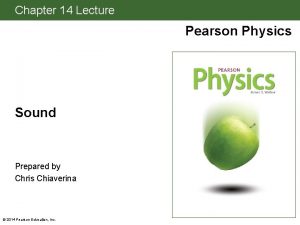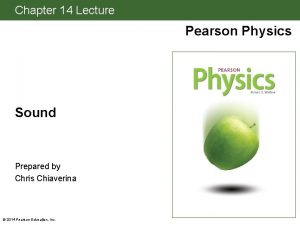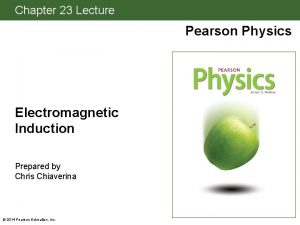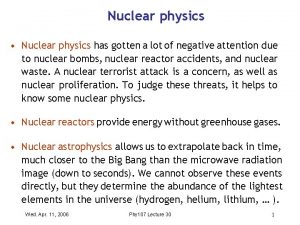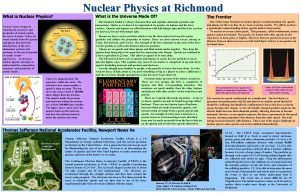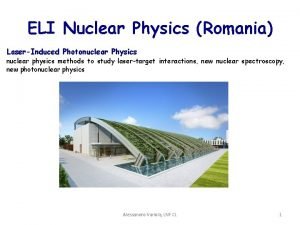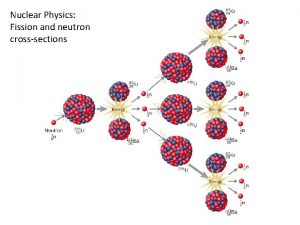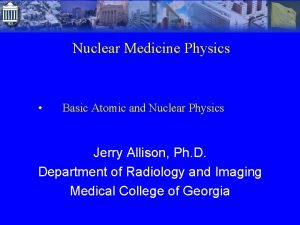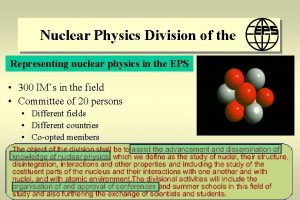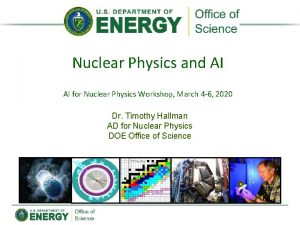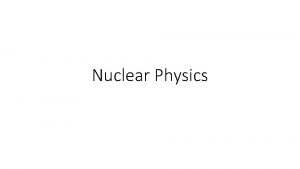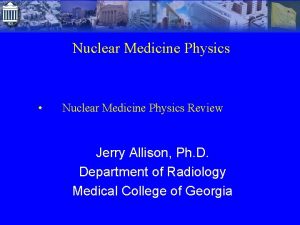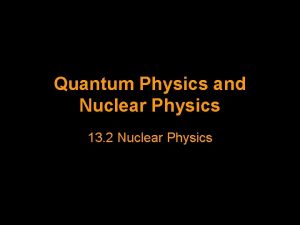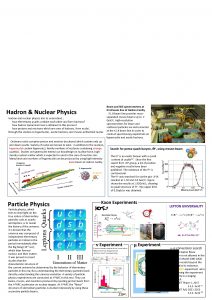Chapter 26 Lecture Pearson Physics Nuclear Physics Prepared



















































































- Slides: 83

Chapter 26 Lecture Pearson Physics Nuclear Physics Prepared by Chris Chiaverina © 2014 Pearson Education, Inc.

Chapter Contents • • The Nucleus Radioactivity Applications of Nuclear Physics Fundamental Forces and Elementary Particles © 2014 Pearson Education, Inc.

The Nucleus • As you will recall, the nucleus is the region of space at the center of the atom that contains all the atom's positive charge and almost all its mass. • The simplest nucleus is that of the hydrogen atom. The nucleus consists of a single proton, with an electric charge +e. All other nuclei contain neutrons in addition to protons. • The neutron is an electrically neutral particle (its electric charge is zero) with a mass just slightly greater than that of the proton. © 2014 Pearson Education, Inc.

The Nucleus • Collectively, protons and neutrons are known as nucleons. Nuclear physics is the study of how nucleons interact with one another in a nucleus. The following figure shows how nucleons are represented. © 2014 Pearson Education, Inc.

The Nucleus • A good way to think of a nucleus is like a bag of marbles, with the closely packed marbles similar to the nucleons. • This close packing in an incredibly small space results in an enormous density of approximately 2. 3 x 1017 kg/m 3. • A typical nucleus, like the one illustrated in the figure on the next slide, is described in terms of the numbers and types of nucleons it contains. © 2014 Pearson Education, Inc.

The Nucleus • The atomic number, Z, is defined as the number of protons in a nucleus. • The number of neutrons in a nucleus is designated by the neutron number, N. • Finally, the total number of nucleons in a nucleus is the mass number, A. © 2014 Pearson Education, Inc.

The Nucleus • Thus, the mass number is the sum of the atomic number and the neutron number: A=Z+N • The composition of a nucleus is expressed with special notation. In general, the nucleus of an element X, with atomic number Z and mass number A is written as follows: A ZX • For example, the nucleus of carbon-14 is written as follows: © 2014 Pearson Education, Inc.

The Nucleus • Notice that the letter C is the chemical symbol for carbon. The atomic number, Z = 6, is written as a subscript in front of the chemical symbol. Likewise, the mass number, A = 14, is written as a superscript. • A similar type of notation is used for subatomic particles—such as the nucleons. Neutrons and protons are represented as follows: = neutron (mass number 1, charge 0) = proton (mass number 1, charge 1) © 2014 Pearson Education, Inc.

The Nucleus • When nuclei contain a large number of neutrons and protons, a circle representing the nucleus is drawn. Inside the circle we write the symbols for neutrons and protons, along with the number of each type of particle. An example is shown in the figure below. © 2014 Pearson Education, Inc.

The Nucleus • The following example shows how to write a symbol representing a nucleus. © 2014 Pearson Education, Inc.

The Nucleus • All nuclei of a given element have the same number of protons. However, atoms of a given element can have different numbers of neutrons in their nuclei. • Nuclei with the same number of protons (the same value of Z) but different numbers of neutrons (different values of N) are referred to as isotopes. • For example, and. . are two isotopes of carbon, with. 6 being the most common one, constituting 89. 89% of naturally occurring carbon. © 2014 Pearson Education, Inc.

The Nucleus • Because different isotopes have different numbers of neutrons, they also have different masses. • Masses are given in atomic mass units. The atomic mass unit (u) is a unit of mass exactly equal to 1/12 the mass of a carbon-12 atom. • In other words, the mass of one atom of. C is exactly 12 u. The value of the atomic mass unit in kilograms is as follows: © 2014 Pearson Education, Inc.

The Nucleus • The following table gives the mass and charge of particles in the atom. • One of Albert Einstein's most famous results is the relationship between mass and energy. According to Einstein, mass and energy are equivalent, with energy equal to mass times the speed of light squared. © 2014 Pearson Education, Inc.

The Nucleus • This equation for mass-energy equivalence is as follows: • As an example, let's apply the mass-energy equivalence to a mass equal to the atomic mass unit, 1 u. © 2014 Pearson Education, Inc.

The Nucleus • Substituting 1. 660539 x 10− 27 kg (the mass of 1 u in kilograms) for m yields E = mc 2 = (1. 660539 x 10− 27 kg)(2. 998 x 108 m/s 2)2 = 1. 492 x 10− 10 J • Converting to electron volts gives E = (1. 492 x 10− 10 J)(1 e. V/1. 6022 x 10− 19 J) = 9. 315 x 108 e. V • This is a significant amount of energy compared to the 13. 6 e. V required to ionize a hydrogen atom. © 2014 Pearson Education, Inc.

The Nucleus • As a general rule, atomic energies are in the range of electron volts (e. V), whereas nuclear energies are in the range of millions of electron volts (Me. V), where 1 Me. V = 106 e. V. • We conclude, then, that 1 atomic mass unit, or 1 u, is equivalent to an amount of energy, Eu, where Eu = 931. 5 Me. V • This conversion between mass and energy will be used later in the study of nuclear reactions. • It should be noted that all the energy in the universe is the result of mass being converted to energy. © 2014 Pearson Education, Inc.

The Nucleus • Like charges repel each other, and this repulsive force increases rapidly as the charges are brought closer together. It follows that protons in a tightly packed nucleus exert large forces on one another. • Using Coulomb's law, it can be shown that the electrostatic force acting on two protons separated by 10− 15 m (a typical nuclear distance) is 230 N. • If this force acted on a proton, it would produce an acceleration of 1. 4 x 1029 m/s 2. This is about 1028 times greater than the acceleration due to gravity! © 2014 Pearson Education, Inc.

The Nucleus • Thus, if protons in a nucleus experienced only the electrostatic force, the nucleus would fly apart. • Because this does not happen, it follows that large attractive forces also act within the nucleus. • The attractive force that holds a nucleus together is called the strong nuclear force. • The properties of the strong nuclear force are as follows: – The strong nuclear force acts over a very short range (~10− 15 m). – The strong nuclear force is always attractive. – The strong nuclear force does not act on electrons. © 2014 Pearson Education, Inc.

The Nucleus • The competition between the repulsive electrostatic forces and the attractive strong nuclear force determines whether a given nucleus is stable. • The following figure shows the neutron number, N, and the atomic number, Z, for stable nuclei. © 2014 Pearson Education, Inc.

The Nucleus • Small nuclei—those with relatively small atomic numbers—are most stable when they have nearly equal numbers of neutrons (N) and protons (Z). For example, . . and. . are both stable. • The condition N = Z is indicated by the straight line in the previous figure. • As the atomic number increases, stable nuclei deviate from the line N = Z. In fact, large stable nuclei tend to contain significantly more neutrons than protons. An example is , which has 110 neutrons but only 75 protons. © 2014 Pearson Education, Inc.

The Nucleus • Since all nucleons experience the strong nuclear force, but only protons experience the electrostatic force, the "extra" neutrons effectively "dilute" the nuclear charge density. This reduces the repulsive forces that would otherwise cause the nucleus to disintegrate. • As the number of protons in a nucleus increases, however, a point is reached at which the strong nuclear force is no longer able to compensate for the repulsive force between protons. © 2014 Pearson Education, Inc.

Radioactivity • In fact, the largest number of protons in a stable nucleus is Z = 83, corresponding to the element bismuth. Nuclei with more than 83 protons are simply not stable. • Large, unstable nuclei can decay in a number of ways. • When an unstable nucleus decays, it emits particles of high-energy photons. The particles and photons emitted when a nucleus decays are known as radioactivity. © 2014 Pearson Education, Inc.

Radioactivity • Four types of radioactivity decay are most common. Three involve the emission of particles, and one involves the emission of an energetic photon. – Alpha particles (denoted by the Greek letter α) consist of two protons and two neutrons. They are actually the nuclei of helium atoms, . . When a nucleus decays by giving off alpha particles, we say that it emits α rays. – Beta particles (denoted by the Greek letter β) are electrons that have been given off during radioactive decay. When a nucleus gives off an electron, we say that it emits a β− ray. © 2014 Pearson Education, Inc.

Radioactivity – A positron, short for "positive electron, " is the antiparticle to an electron. Positrons have the same mass as an electron, but the opposite charge (+e). If a nucleus gives off positrons when it decays, we say that it emits β+ rays. In a nuclear equation, we write a positron as e+. – A nucleus in an excited state can drop to a lower-energy state and emit a high-energy photon known as a gamma ray. We denote gamma rays with the Greek letter γ. © 2014 Pearson Education, Inc.

Radioactivity • Radioactivity was discovered by the French physicist Antoine Henri Becquerel (1852– 1908). He observed that uranium was able to expose photographic film, even when the film was covered. This was proof of the penetrating ability of radioactivity. • Typical penetrating abilities for three types of rays are as follows: – Alpha (α) rays can barely penetrate a sheet of paper and are stopped by a sheet of aluminum. – Beta rays (both β− and β+) can penetrate a few millimeters of aluminum. © 2014 Pearson Education, Inc.

Radioactivity – Gamma (γ) rays pass right through a thin aluminum sheet and can even penetrate several centimeters of lead. • When a large nucleus (larger than iron) undergoes radioactive decay, the mass of the system decreases. The figure on the next slide shows that the mass of a large nucleus before decay is greater than the mass of the resulting nucleus plus the mass of the particles it emits. © 2014 Pearson Education, Inc.

Radioactivity • A similar change in mass occurs with small nuclei. For example, the mass of a helium nucleus is less than the mass of 2 protons and 2 neutrons that are separated from one another, as is indicated in the figure below. © 2014 Pearson Education, Inc.

Radioactivity • This means that energy will be released if 2 protons and 2 neutrons are put together to form a helium nucleus. • In general, the difference in energy between a complete nucleus and its separated individual parts is referred to as the nuclear binding energy. • Nuclear binding energy is released when small nuclei are fused together to form a larger nucleus, in a process called fusion, and also when large nuclei decay into smaller nuclei, in a process called fission. The energy released in fusion or fission corresponds to a decrease in mass, according to E = |Δm|c 2. © 2014 Pearson Education, Inc.

Radioactivity • When a nucleus decays by giving off an α particle, it loses two protons and two neutrons. As a result, its atomic number, Z, decreases by 2, and its mass number, A, decreases by 4. Symbolically, this process can be written as follows: • In this decay, X is referred to as the parent nucleus, and Y is the daughter nucleus. • The sum of the atomic numbers on the right side of the reaction is equal to the atomic number on the left side. The same is true for the mass numbers. © 2014 Pearson Education, Inc.

Radioactivity • The following example illustrates how the energy released when a nucleus undergoes alpha decay is determined. © 2014 Pearson Education, Inc.

Radioactivity © 2014 Pearson Education, Inc.

Radioactivity • The basic process that occurs in beta decay is the conversion of a neutron to a proton, an electron (e−), and an antineutrino. neutron proton + electron + antineutrino • Neutrinos have very little mass (about a hundred -thousandth of the mass of an electron) and little interaction with matter. Only 1 in every 200 million neutrinos that pass through the Earth interacts with it in any way. © 2014 Pearson Education, Inc.

Radioactivity • The force responsible for beta decay is known as the weak nuclear force. This force is short range and is important only within the nucleus of an atom. • When a nucleus decays by giving off an electron, its mass number is unchanged (since protons and neutrons count equally in determining A), but its atomic number increases by 1. The process can be represented symbolically as follows: © 2014 Pearson Education, Inc.

Radioactivity • In some cases a nucleus gives off a positron (e+) rather than an electron. • In the following example, the energy released when carbon-14 undergoes beta decay is determined. © 2014 Pearson Education, Inc.

Radioactivity © 2014 Pearson Education, Inc.

Radioactivity • An atom in an excited state can emit a photon when one of its electrons drops to a lower energy level. Similarly, a nucleus in an excited state can emit a photon as it decays to state of lower energy. • High-energy photons emitted by nuclei are known as gamma (γ) rays. Consider the following decay process: • The asterisk on the nitrogen symbol indicates that the nitrogen nucleus has been left in an excited state as a result of beta decay. © 2014 Pearson Education, Inc.

Radioactivity • Subsequently, the nitrogen nucleus may decay to its ground state, with the emission of a γ ray. • Radioactive decays may occur in series. Consider an unstable nucleus that decays and produces a daughter nucleus. If the daughter nucleus is also unstable, it eventually decays and produces its own daughter nucleus, which may in turn be unstable. • In such cases, an original parent nucleus can produce a series of related nuclei in a process referred to as a radioactive decay series. © 2014 Pearson Education, Inc.

Radioactivity • An example of a radioactive decay series is shown in the figure below. • As the figure indicates, as uranium-235 decays, it changes to a number of intermediate nuclei before becoming the stable nucleus at the end of the series, lead-207. © 2014 Pearson Education, Inc.

Radioactivity • Notice that several of the intermediate nuclei in this series can decay in two different ways—either by alpha decay or by beta decay. • The rate at which nuclear decay occurs—that is, the number of decays per second—is referred to as the activity. • A highly active material has many nuclear decays occurring in one second. For example, a typical sample of radium (usually a fraction of a gram) might have 105 to 1010 radioactive decays per second. © 2014 Pearson Education, Inc.

Radioactivity • The unit used to measure activity is the curie, named in honor of Pierre Curie (1859– 1906) and Marie Curie (1867– 1934), pioneers in the study of radioactivity. • The curie (Ci) is defined as follows: 1 curie = 1 Ci = 3. 7 x 1010 decays/s • The reason for this choice is that 1 Ci is roughly the activity of 1 g of radium. • In SI units, activity is measured in terms of the becquerel (Bq): 1 becquerel = 1 Bq = 1 decay/s © 2014 Pearson Education, Inc.

Applications of Nuclear Physics • Chemical reactions involve changes to the electron clouds that surround a nucleus; nuclear reactions involve changes to neutrons and protons within the nucleus. • Nuclear reactions generally have no effect on chemical reactions, and chemical reactions don't alter the behavior of the nucleus. • Just as chemical reactions are an important part of our everyday lives, so too are nuclear reactions. © 2014 Pearson Education, Inc.

Applications of Nuclear Physics • A new type of natural phenomenon was discovered in 1939 when Otto Hahn (1879– 1968) and Fritz Strassmann (1902– 1980) discovered that a uranium nucleus can break into two pieces. • In general, the process in which a large nucleus splits into two smaller nuclei is called nuclear fission. The mass of the system decreases during the fission process, and energy is released. © 2014 Pearson Education, Inc.

Applications of Nuclear Physics • Nuclear fission releases far more energy than any chemical reaction. This follows from the fact that nuclear energies are in the range of millions of electron volts, compared with atomic (chemical) energies, which range from 1 to 10 electron volts. • The first step in a typical fission reaction occurs when a slow neutron is absorbed, or captured, by a uranium-235 nucleus. The step increases the mass number of the nucleus by 1 and leaves it in an excited state. © 2014 Pearson Education, Inc.

Applications of Nuclear Physics • The excited nucleus oscillates wildly and becomes highly distorted, as depicted in the figure below. • In many respects, the nucleus behaves like a spinning drop of water. Like a drop of water, the nucleus can distort only so much before it breaks apart (fissions) into smaller pieces. • There about 90 different ways in which the uranium 235 nucleus can undergo fission. © 2014 Pearson Education, Inc.

Applications of Nuclear Physics • The following example illustrates one of the fission reactions that uranium-235 can undergo. © 2014 Pearson Education, Inc.

Applications of Nuclear Physics © 2014 Pearson Education, Inc.

Applications of Nuclear Physics • Knocking down one domino in a long line of dominoes can set off a chain reaction. The same thing can happen with nuclei. • Suppose, for example, that a fission reaction gives off two neutrons and that both neutrons cause additional fissions in other nuclei. These nuclei in turn give off two neutrons. • Starting with one nucleus to begin the chain reaction, we have two nuclei in the second generation of the chain, four nuclei in the third generation, and so on, as indicated in the figure on the next slide. © 2014 Pearson Education, Inc.

Applications of Nuclear Physics • Clearly, a rapidly developing runaway chain reaction, such as the one just described, will produce an explosive release of an enormous amount of energy. © 2014 Pearson Education, Inc.

Applications of Nuclear Physics • The first controlled nuclear chain reaction was achieved by Enrico Fermi (1901– 1954) in 1942. • His reactor consisted of blocks of uranium (the fuel) stacked together with blocks of graphite (the moderator) to form a large pile. In such a nuclear reactor, the moderator slows the neutrons given off during fission, making it more likely that they will be captured by other uranium nuclei and cause additional fissions. © 2014 Pearson Education, Inc.

Applications of Nuclear Physics • The rate of reaction is adjusted with control rods made of a material (such as cadmium) that is very efficient at absorbing neutrons. • When, on average, one neutron given off by a fission reaction produces an additional reaction, the reactor is said to be critical. • If the control rods are pulled out of the pile too far, the number of neutrons causing fission reactions becomes greater than one, and a runaway reaction begins to occur. © 2014 Pearson Education, Inc.

Applications of Nuclear Physics • All forms of energy come with risks. Nuclear power is no exception. It's important for people to know some of the basic facts about different types of power generation, including nuclear power, so they can make intelligent decisions when weighing the potential benefits and risks. © 2014 Pearson Education, Inc.

Applications of Nuclear Physics • Not only can nuclei split apart, they can also be made to join, or fuse, together. • When two light nuclei combine to form a more massive nucleus, the reaction is referred to as nuclear fusion. The mass of the system decreases when light nuclei fuse, and energy is released. • Combining two small nuclei into a single nucleus requires tremendous amounts of energy—enough to overcome the electrostatic repulsions acting between protons. © 2014 Pearson Education, Inc.

Applications of Nuclear Physics • The temperature required for combining nuclei is about 107 K. When the temperature is high enough to initiate fusion, the process is called a thermonuclear fusion reaction. • Thermonuclear fusion occurs in the cores of stars. In fact, all stars generate energy through thermonuclear reactions. • At the moment, the Sun is converting some 600, 000 tons of hydrogen into helium every second. This process is predicted to continue for about 10 billion years. © 2014 Pearson Education, Inc.

Applications of Nuclear Physics • Scientists are working to control nuclear fusion reactions and use them to generate electric power. • To date, sustained nuclear fusion reactions require more energy than they produce. • Two methods—magnetic confinement and inertial confinement—are commonly used to produce controlled fusion. Both methods use extremely high temperatures to completely ionize atoms into a gaslike collection of electrons and nuclei known as a plasma. © 2014 Pearson Education, Inc.

Applications of Nuclear Physics • In addition to being a source of energy, radioactivity is also useful in the fields of archeology and paleontology. In these fields, radioactive dating is frequently used to determine the age of ancient, once-living organisms. • In many ways radioactive dating is similar to flipping a coin. Imagine that a coin represents a nucleus, and the side that comes up when the coin is flipped determines whether the nucleus decays. • For example, suppose you flip 64 coins, and then remove all of those that come up tails. On average, you would expect to remove 32 coins. • So it is with nuclear decay. In fact, we characterize the nuclear decay of a substance by its half-life. © 2014 Pearson Education, Inc.

Applications of Nuclear Physics • When you flip the remaining 32 coins, you expect an average of 16 more to be removed, and so on. Each time you flip a set of coins, the number that remains is on average half of the original number. • The points in the figure below show the results after a few tosses. © 2014 Pearson Education, Inc.

Applications of Nuclear Physics • Nuclear decay is similar to coin flips, each round of which cuts the number of coins in half. In fact, the nuclear decay of a substance is characterized by its half-life. • The time required for half of the nuclei in a sample of a radioactive material to decay is known as the half-life, T 1/2. • The number of nuclei decaying at any moment is proportional to the number of nuclei present. This fact turns out to be very useful. © 2014 Pearson Education, Inc.

Applications of Nuclear Physics • Because the decay rate depends on time in a straightforward way, it can be used as sort of a clock. In fact, radioactivity can be used to date items from the past. • To be specific, if you know both the initial activity rate of a sample, Rinitial, and its current activity, Rcurrent, you can calculate the amount of time that has passed with the following equation: © 2014 Pearson Education, Inc.

Applications of Nuclear Physics • The carbon in Earth's biosphere consists of both carbon-12 and carbon-14. Carbon-14 is unstable with a half-life of 5730 years. Carbon-12 is stable and does not decay. • Even though carbon-14 decays, the ratio of carbon-14 to carbon-12 in Earth's atmosphere remains constant because high-energy cosmic rays from outer space continuously enter Earth's upper atmosphere and cause nuclear reactions involving nitrogen-14. These reactions result in a steady production of carbon-14. © 2014 Pearson Education, Inc.

Applications of Nuclear Physics • Living organisms have the same ratio of carbon-14 to carbon-12 as the atmosphere, since they continuously take in carbon from their surroundings. • When an organism dies, however, the absorption of carbon ceases and the carbon-14 in the organism (in its wood, bone, shell, etc. ) begins to decay. • The figure below illustrates this process. © 2014 Pearson Education, Inc.

Applications of Nuclear Physics • Notice that the carbon-14 activity of an organism is constant until it dies, at which point the activity decreases exponentially with a half-life of 5730 years. • Careful measurements show that the initial activity of a 1 -gram sample of carbon is 0. 231 decays of carbon-14 per second. This initial activity is shown in the previous figure. • It follows that 5730 years after the organism dies, its carbon-14 activity per gram will have decreased by half (½ x 0. 231 decays/s = 0. 116 decays/s). © 2014 Pearson Education, Inc.

Applications of Nuclear Physics • The passing of another 5730 years will once again reduce the activity by another factor of two, and so on. • Thus measuring the current carbon-14 activity in a sample of a once-living organism gives a direct indication of the time that has elapsed since the death of the organism. © 2014 Pearson Education, Inc.

Applications of Nuclear Physics • The decay of radioactive isotopes has many applications in medicine. • While the radiation given off by a radioactive nucleus may kill a cell or damage its DNA, its effects can also be beneficial. For example, it can be used to kill cancerous cells or for diagnostic purposes. • One of the most amazing uses of radioactive decay is the diagnostic technique known as positron-emission tomography, or PET. © 2014 Pearson Education, Inc.

Applications of Nuclear Physics • A PET scan is produced with radiation that emerges from within the body, as opposed to radiation that is generated externally and then passes through the body. • Remarkably, the radiation that creates a PET scan is produced by the annihilation of matter and antimatter within the patient's body. • This annihilation results in the production of γ rays that emerge from the body. The γ rays are then observed with specialized detectors that aid in the location of tumors in the brain or other parts of the body. © 2014 Pearson Education, Inc.

Fundamental Forces and Elementary Particles • Scientists have long sought to identify the fundamental building blocks of all matter and the forces that mediate the interactions between them. • There are four fundamental forces in nature. They are the strong nuclear force, the electromagnetic force, the weak nuclear force, and the force of gravity. • The table on the next slide gives the relative strengths and ranges of these forces. © 2014 Pearson Education, Inc.

Fundamental Forces and Elementary Particles • All objects with mass experience the gravitational force. Similarly, all objects with electric charge experience electromagnetic forces. As for the weak and strong nuclear forces, some particles experience only the weak force, but others experience both the weak and the strong forces. © 2014 Pearson Education, Inc.

Fundamental Forces and Elementary Particles • While the universe today has four fundamental forces, this has not always been the case. • Just after the Big Bang the four forces were merged into a single force known as the unified force. This situation lasted for an incredibly brief interval of time—approximately 10− 43 s. • As the early universe expanded and cooled from its original temperature of approximately 1032 K, it underwent a type of "phase transition" in which the gravitational force took on a separate identity. © 2014 Pearson Education, Inc.

Fundamental Forces and Elementary Particles • This transition was the first of three such transitions to occur in the early universe, as is shown in the figure below. • At 10− 35 s, when the temperature was 1028 K, the strong force became a separate force. Similarly, the weak force became separate at 10− 10 s, when the temperature was 1015 K. © 2014 Pearson Education, Inc.

Fundamental Forces and Elementary Particles • Let's take a closer look at the fundamental forces and the transitions between them. • As a first example, the electromagnetic force combines the forces associated with both electricity and magnetism. • Although electricity and magnetism were originally thought to be separate forces, the work of James Clerk Maxwell (1831– 1879) and others showed that these forces are simply different aspects of the same underlying force. • Thus, theory of electromagnetism can be thought of as the first unified field theory. © 2014 Pearson Education, Inc.

Fundamental Forces and Elementary Particles • At times earlier than 10− 10 s after the Big Bang, the weak nuclear force was indistinguishable from the electromagnetic force. Thus, even though these forces seem very different today, we can recognize them as different aspects of the same underlying force. • The theory that links the weak force and the electromagnetic force is called the electroweak theory. © 2014 Pearson Education, Inc.

Fundamental Forces and Elementary Particles • Although no one has yet succeeded in producing a theory combining the electroweak force and the strong nuclear force, most physicists feel confident that such a theory exists. This hypothetical theory is referred to as the grand unified theory, or GUT. • A theory that encompasses gravity and the other three forces of nature is one of the ultimate goals of physics. • As things stand today, the electroweak theory is probably the best tested of all descriptions of the forces of nature. Still it includes only electromagnetism and the weak nuclear force. © 2014 Pearson Education, Inc.

Fundamental Forces and Elementary Particles • String theory is an approach that does incorporate gravity, but many of its predictions (like extra dimensions) are still controversial. • Unifying the forces of nature is an area of active research that may require a new generation of physicists for its resolution. © 2014 Pearson Education, Inc.

Fundamental Forces and Elementary Particles • At one point it was thought that atoms were elementary particles—one type for each element. This idea was put to rest when atoms were discovered to be made up of electrons, protons, and neutrons. • Of these three particles, only the electron is currently considered to be elementary—protons and neutrons are now known to be composed of still smaller particles. © 2014 Pearson Education, Inc.

Fundamental Forces and Elementary Particles • Particles that are acted on by the weak nuclear force but not the strong nuclear force are referred to as leptons. Only six leptons are known to exist, and all are listed in the table below. • The most familiar leptons are the electron and its corresponding neutrino—both of which are stable. © 2014 Pearson Education, Inc.

Fundamental Forces and Elementary Particles • No internal structure has ever been detected in any of the leptons. As a result, all six leptons have the status of true elementary particles. • Hadrons are particles that are acted on by both the weak and strong nuclear forces. They are also acted on by gravity, since all hadrons have mass. • Two of the most familiar hadrons are the proton and the neutron. • A partial list of the hundreds of hadrons known to exist is given in the table on the next slide. © 2014 Pearson Education, Inc.

Fundamental Forces and Elementary Particles • Notice that the proton is the only stable hadron (though some theories suggest that even it may decay with an incredibly long half-life of 1035 years). © 2014 Pearson Education, Inc.

Fundamental Forces and Elementary Particles • None of the hadrons are elementary particles. All hadrons are composed of either two or three smaller particles called quarks. • Hadrons formed from two quarks are referred to as mesons; hadrons formed from three quarks are baryons. • To account for the internal structure observed in hadrons, Murray Gell-Mann (b. 1929) and George Zweig (b. 1937) independently proposed in 1964 that all hadrons are composed of a number of truly elementary particles that Gell-Mann dubbed quarks. © 2014 Pearson Education, Inc.

Fundamental Forces and Elementary Particles • Originally, it was proposed that there are three types of quarks, arbitrarily named up (u), down (d), and strange (s). • The discovery of more massive hadrons necessitated the addition of three more quarks. The equally whimsical names for these new quarks are charmed (c), top or truth (t), and bottom or beauty (b). • The table on the next slide lists the six quarks, some of their properties, and their antiparticles. © 2014 Pearson Education, Inc.

Fundamental Forces and Elementary Particles • Quarks are unique elementary particles in a number of ways. For one, they all have charges that are fractions of the charge of the electron. As can be seen in the above table, some quarks have a charge of +⅔e or −⅔e, and others have a charge of +⅓e or −⅓e. © 2014 Pearson Education, Inc.

Fundamental Forces and Elementary Particles • Quarks have never been observed. It is now believed that a free, independent quark cannot exist; quarks must always be bound with other quarks inside a hadron. This concept is referred to as quark confinement. • The smallest system of bound quarks that can be observed as an independent particle is a pair of quarks. In fact, mesons consist of bound pairs of quarks and antiquarks, as illustrated in the figure on the next slide. © 2014 Pearson Education, Inc.

Fundamental Forces and Elementary Particles • It should be noted that quarks are always bound in combinations that result in a net charge that is an integer multiple of e. • Baryons are bound systems consisting of three quarks, as is shown in the above figure. The quark compositions of a variety of hadrons are given in the table on the next slide. © 2014 Pearson Education, Inc.

Fundamental Forces and Elementary Particles • Not long after the quark model was introduced, it was found that some quark compositions implied a violation of basic principles of quantum mechanics. © 2014 Pearson Education, Inc.

Fundamental Forces and Elementary Particles • To resolve these discrepancies, it was suggested that quarks must come in three varieties, which were given the completely arbitrary but colorful names red, green, and blue. • Though these quark "colors" have nothing to do with visible colors in the electromagnetic spectrum, they explain other experimental observations that were previously difficult to understand. • The theory of how quarks of different "colors" interact with one another is called quantum chromodynamics, or QCD. © 2014 Pearson Education, Inc.
 Lesson 15 nuclear quest nuclear reactions
Lesson 15 nuclear quest nuclear reactions Fisión nuclear vs fision nuclear
Fisión nuclear vs fision nuclear 01:640:244 lecture notes - lecture 15: plat, idah, farad
01:640:244 lecture notes - lecture 15: plat, idah, farad Pearson education inc publishing as pearson prentice hall
Pearson education inc publishing as pearson prentice hall 2011 pearson education inc
2011 pearson education inc Pearson vue ceo
Pearson vue ceo Stress management for life 5th edition
Stress management for life 5th edition Pearson education inc publishing as pearson prentice hall
Pearson education inc publishing as pearson prentice hall Pearson education inc. 2012
Pearson education inc. 2012 2008 pearson prentice hall inc
2008 pearson prentice hall inc Quantum and nuclear physics
Quantum and nuclear physics Magic number in nuclear physics
Magic number in nuclear physics Skobeltsyn institute of nuclear physics
Skobeltsyn institute of nuclear physics Nuclear energy
Nuclear energy Scattering cross section in nuclear physics
Scattering cross section in nuclear physics Budker
Budker Petersburg nuclear physics institute
Petersburg nuclear physics institute Quantum nuclear physics
Quantum nuclear physics Nuclear physics
Nuclear physics Nuclear physics topics for presentation
Nuclear physics topics for presentation Nuclear physics
Nuclear physics Nuclear physics
Nuclear physics Nuclear physics
Nuclear physics Nuclear physics b
Nuclear physics b Magic number
Magic number Nuclear physics
Nuclear physics Budker
Budker Nuclear physics day
Nuclear physics day Classical mechanics
Classical mechanics Physics 101 lecture notes pdf
Physics 101 lecture notes pdf Phy101 lecture 1
Phy101 lecture 1 Physics 101 lecture notes pdf
Physics 101 lecture notes pdf Waves notes pdf
Waves notes pdf Atmospheric physics lecture notes
Atmospheric physics lecture notes Fundamentals of design
Fundamentals of design Pearson physics
Pearson physics Pearson physics
Pearson physics Chain physics
Chain physics Pearson physics
Pearson physics Constant velocity position time graph
Constant velocity position time graph Pearson physics
Pearson physics Pearson physics
Pearson physics Pearson physics
Pearson physics Pearson
Pearson 12x12x12x12x12x12x12
12x12x12x12x12x12x12 Chapter 25 nuclear chemistry answer key
Chapter 25 nuclear chemistry answer key Chapter 21 review nuclear chemistry
Chapter 21 review nuclear chemistry Chapter 25 nuclear chemistry
Chapter 25 nuclear chemistry Chapter 25 nuclear chemistry
Chapter 25 nuclear chemistry Chapter 10 nuclear chemistry
Chapter 10 nuclear chemistry Chapter 10 nuclear chemistry
Chapter 10 nuclear chemistry The business plan should be prepared by
The business plan should be prepared by After a node has prepared an lsp it must be disseminated to
After a node has prepared an lsp it must be disseminated to Dramatic irony romeo and juliet act 4
Dramatic irony romeo and juliet act 4 How is periscope prepared
How is periscope prepared What is a preliminary strand test
What is a preliminary strand test Use in wet and dry land preparation
Use in wet and dry land preparation Trading account format
Trading account format The business of making and serving prepared food and drink.
The business of making and serving prepared food and drink. An item prepared with the intent to deceive
An item prepared with the intent to deceive Holt company's variable expenses are 70 of sales
Holt company's variable expenses are 70 of sales Plokmijnuhbygvtfcrdxeszwaq
Plokmijnuhbygvtfcrdxeszwaq Oxymoron in storm on the island
Oxymoron in storm on the island Drops are liquid dosage form meant for
Drops are liquid dosage form meant for Preparing for a client meeting
Preparing for a client meeting Always be prepared to give an answer
Always be prepared to give an answer Always be ready to give an answer
Always be ready to give an answer Preparation of guiding planes
Preparation of guiding planes Benefits of bsn-prepared nurses
Benefits of bsn-prepared nurses Past tense chart
Past tense chart Heat method of effervescent granules
Heat method of effervescent granules How to prepare to preach the word of god
How to prepare to preach the word of god How the periscope works
How the periscope works In williamson’s synthesis, ethoxyethane is prepared by-
In williamson’s synthesis, ethoxyethane is prepared by- The first step in the liquidation of a partnership is to
The first step in the liquidation of a partnership is to Be prepared to share the hope
Be prepared to share the hope Standard cost model
Standard cost model Let's get prepared
Let's get prepared Conclusion in research sample
Conclusion in research sample Award prepared
Award prepared Trading account example
Trading account example Institutional catering meaning
Institutional catering meaning Maceration in pharmaceutics
Maceration in pharmaceutics Ezra prepared his heart
Ezra prepared his heart











